药用丁基橡胶塞培训教材-技术部
- 格式:pdf
- 大小:469.93 KB
- 文档页数:11
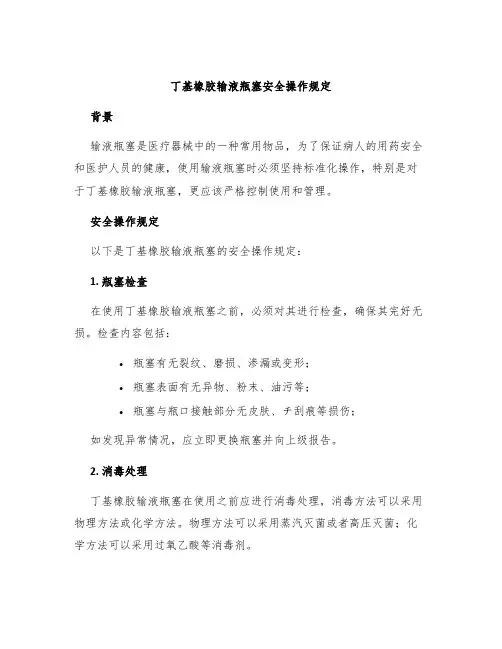
丁基橡胶输液瓶塞安全操作规定背景输液瓶塞是医疗器械中的一种常用物品,为了保证病人的用药安全和医护人员的健康,使用输液瓶塞时必须坚持标准化操作,特别是对于丁基橡胶输液瓶塞,更应该严格控制使用和管理。
安全操作规定以下是丁基橡胶输液瓶塞的安全操作规定:1. 瓶塞检查在使用丁基橡胶输液瓶塞之前,必须对其进行检查,确保其完好无损。
检查内容包括:•瓶塞有无裂纹、磨损、渗漏或变形;•瓶塞表面有无异物、粉末、油污等;•瓶塞与瓶口接触部分无皮肤、チ刮痕等损伤;如发现异常情况,应立即更换瓶塞并向上级报告。
2. 消毒处理丁基橡胶输液瓶塞在使用之前应进行消毒处理,消毒方法可以采用物理方法或化学方法。
物理方法可以采用蒸汽灭菌或者高压灭菌;化学方法可以采用过氧乙酸等消毒剂。
3. 瓶塞安装在安装瓶塞时,应根据相应的要求进行操作。
安装时禁止使用锤击等粗鲁操作,瓶塞的卡口应完全卡住瓶口,不能卡歪,否则将会导致漏药。
4. 输液前检查丁基橡胶输液瓶塞安装后,应进行输液前的检查,确保瓶塞无渗漏、破损等异常状况,输液管道无异物和漏气等情况。
5. 瓶塞更换瓶塞使用期限一般为4个小时,超时即应更换,禁止重复使用。
在更换时应注意避免瓶塞和其他物品碰撞,确保操作正确。
6. 瓶塞管理将瓶塞放置在光线充足、通风干燥的地方,存放温度不超过25摄氏度。
禁止紫外线照射,禁止叠压。
废弃的瓶塞应按照医院的相关要求分类存储和处理,避免对环境造成污染。
结语丁基橡胶输液瓶塞作为常用的医疗器械,对病人的用药安全以及医务人员的健康起到了至关重要的作用。
正确认识和使用输液瓶塞,严格按照操作规定进行使用、管理,是医护人员应该始终遵守和坚持的。
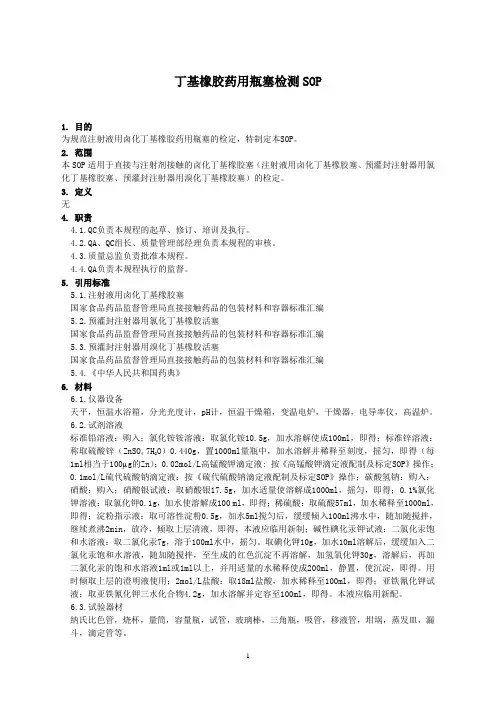
丁基橡胶药用瓶塞检测SOP1. 目的为规范注射液用卤化丁基橡胶药用瓶塞的检定,特制定本SOP。
2. 范围本SOP适用于直接与注射剂接触的卤化丁基橡胶塞(注射液用卤化丁基橡胶塞、预灌封注射器用氯化丁基橡胶塞、预灌封注射器用溴化丁基橡胶塞)的检定。
3. 定义无4. 职责4.1.QC负责本规程的起草、修订、培训及执行。
4.2.QA、QC组长、质量管理部经理负责本规程的审核。
4.3.质量总监负责批准本规程。
4.4.QA负责本规程执行的监督。
5. 引用标准5.1.注射液用卤化丁基橡胶塞国家食品药品监督管理局直接接触药品的包装材料和容器标准汇编5.2.预灌封注射器用氯化丁基橡胶活塞国家食品药品监督管理局直接接触药品的包装材料和容器标准汇编5.3.预灌封注射器用溴化丁基橡胶活塞国家食品药品监督管理局直接接触药品的包装材料和容器标准汇编5.4.《中华人民共和国药典》6. 材料6.1.仪器设备天平,恒温水浴箱,分光光度计,pH计,恒温干燥箱,变温电炉,干燥器,电导率仪,高温炉。
6.2.试剂溶液标准铅溶液:购入;氯化铵铵溶液:取氯化铵10.5g,加水溶解使成100ml,即得;标准锌溶液:称取硫酸锌(ZnSO4·7H2O)0.440g,置1000ml量瓶中,加水溶解并稀释至刻度,摇匀,即得(每1ml相当于100µg的Zn);0.02mol/L高锰酸钾滴定液: 按《高锰酸钾滴定液配制及标定SOP》操作;0.1mol/L硫代硫酸钠滴定液:按《硫代硫酸钠滴定液配制及标定SOP》操作;碳酸氢钠:购入;硝酸:购入;硝酸银试液:取硝酸银17.5g,加水适量使溶解成1000ml,摇匀,即得;0.1%氯化钾溶液:取氯化钾0.1g,加水使溶解成100 ml,即得;稀硫酸:取硫酸57ml,加水稀释至1000ml,即得;淀粉指示液:取可溶性淀粉0.5g,加水5ml搅匀后,缓缓倾入100ml沸水中,随加随搅拌,继续煮沸2min,放冷,倾取上层清液,即得,本液应临用新制;碱性碘化汞钾试液:二氯化汞饱和水溶液:取二氯化汞7g,溶于100ml水中,摇匀。
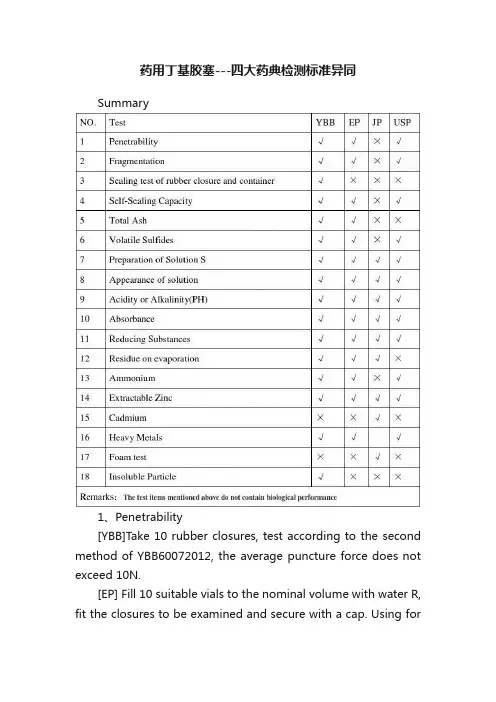
药用丁基胶塞---四大药典检测标准异同Summary1、Penetrability[YBB]Take 10 rubber closures, test according to the second method of YBB60072012, the average puncture force does not exceed 10N.[EP] Fill 10 suitable vials to the nominal volume with water R, fit the closures to be examined and secure with a cap. Using foreach closure a new, lubricated long-bevel(1) (bevel angle 12 ± 2°) hypodermic needle with an external diameter of 0.8 mm, pierce the closures with the needle perpendicular to the surface. The force required for piercing, determined with an accuracy of ± 0.25 N (25 gf), is not greater than 10 N (1 kgf) for each closure.[JP]None[USP]Fill 10 suitable vials to the nominal volume with water, fit the closures to be examined, and secure with a cap. Using a new hypodermic needle as described above for each closure, pierce the closure with the needle perpendicular to the surface.Requirement—The force for piercing is no greater than 10 N (1 kgf) f or each closure, determined with an accuracy of ± 0.25 N (25 gf).2、Fragmentation[YBB]Take 10 rubber closures, test according to the second method of YBB60082012, The total number of fragments does not exceed 5.[EP] For closures intended to be pierced by a hypodermic needle, carry out the following test. If the closures are to be used for aqueous preparations, place in12 clean vials a volume of water R corresponding to the nominal volume minus4 ml, close the vials with the closures to be examined, secure with a cap andallow to stand for 16 h. If the closures are to be used with dry preparations, close 12 clean vials with the closures to be examined. Using a lubricated long-bevel(1) (bevel angle 12 ±2°) hypodermic needle with an external diameter of 0.8 mm fitted to a clean syringe, inject into the vial 1 ml of water R and remove 1 ml of air ; carry out this operation 4 times for each closure,piercing each time at a different site. Use a new needle for each closure and check that the needle is not blunted during the test. Pass the liquid in the vials through a filter having approxi mately 0.5 μm pores. Count the fragments of rubber visible to the naked eye. The total number of fragments does not exceed5. This limit is based on the assumption that fragments witha diameter equal toor greater than 50 μm are visible to the naked eye; in cases of doubt or dispute, the fragments are examined with a microscope to verify their nature and size. [JP] None[USP] Closures for Liquid Preparations—Fill 12 clean vials with water to 4 mL less than the nominal capacity. Fit the closures to be examined, secure with acap, and allow to stand for 16 hours.Closures for Dry Preparations— Fit closures to be examined into 12 cleanvials, and secure each with a cap.Procedure— Using a hypodermic needle as described above fitted to a cleansyringe, inject into each vial 1 mL of water while removing 1 mL of air. Repeat this procedure 4 times for each closure, piercing each time at a different site.Use a new needle for each closure, checking that it is not blunted during the test.Filter the toatal volume of liquid in all the vials through a single filter with a nominal pore size no greater than 0.5 μm. Count the rubber fragments on the surface of the filter visible to the naked eye.Requirement— There are no more than 5 fragments visible. This limit is based on the assumption that fragments with adiameter >50 μm are visible to the naked eye. In case of doubt or dispute, the particles are examined microscopically to verify their nature and size.3、Sealing test of rubber closure and container[YBB] Take 10 rubber closures into the beaker, boil for 5 min , take out and dry 1h at 70℃ and ready to use. Fill 10 suitable vials to the nominal volume with water, fit the closures to be examined and secure with a cap. Heat in an autoclave so that a temperature of 121 ± 2 °C and maintain at this temperature for 30 min.Cool to room temperature and then place 24h, Immerse the vials upside down ina 10% solution of methylene blue R and reduce the external pressure by 25 kPafor 30 min. Restore atmospheric pressure and leave the vials immersed for 30 min. Rinse the outside of the vials. None of the vials contains any trace of colored solution.[EP]None[JP]None[USP] None4、Self-Sealing Capacity[YBB]Take the samples from sealing test of rubber closure and container, using for a hypodermic needle (YBB60082012 method 2), pierce each closure 3 times, change the hypodermic needle after it is used 10 times ,piercing each time at a different site.The vials upside down in a 10% solution of methylene blue R and reduce the external pressure by 25 kPa for 30 min. Restore atmospheric pressure and leave the vials immersed for 30 min. Rinse the outside of the vials. None of the vials contains any trace of colored solution.[EP]For closures intended to be used with multidosecontainers, carry out the following test. Fill 10 suitable vials to the nominal volume with water R, fit the closures to be examined and secure with a cap. Using for each closure a new hypodermic needle with an external diameter of 0.8 mm, pierce each closure 10 times, piercing each time at a different site. Immerse the vials upright in a 1 g/l solution of methylene blue R and reduce the external pressure by 27 kPa for 10 min. Restore atmospheric pressure and leave the vials immersed for 30 min.Rinse the outside of the vials. None of the vials contains any trace of coloured solution.[JP]None[USP]Procedure—Fill 10 suitable vials with water to the nominal volume. Fit the closures that are to be examined, and cap. Using a new hypodermic needle as described above for each closure, pierce each closure 10 times, piercing each time at a different site. Immerse the 10 vials in a solution of 0.1% (1 g per L) methylene blue, and reduce the external pressure by 27 kPa for 10 minutes.Restore to atmospheric pressure, and leave the vials immersed for 30 minutes.Rinse the outside of the vials.Requirement—None of the vials contain any trace of blue solution.5、Total Ash[YBB] Take the rubber closures, test according to YBB600212012, should be comply with the standard.[EP]The total ash (2.4.16) is within ± 10 per cent of the result obtained with the type sample.[JP]None[USP] None6、Volatile Sulfides[YBB]Take the rubber closures, according to the YBB60052012, should be comply with the standard.[EP] Place closures, cut if necessary, with a total surface area of 20 ± 2 cm2 in a 100 ml conical flask and add 50 ml of a 20 g/l solution of citric acid R. Place a piece of lead acetate paper R over the mouth of the flask and maintain the paper in position by placing over it an inverted weighing bottle. Heat in an autoclave at 121 ± 2℃ for 30 min. Any black stain on the paper is not more intense than that of a standard prepared at the same time in the same manner using 0.154 mg of sodium sulphide R and 50 ml of a 20 g/l solution of citric acid R.[JP]None[USP] Procedure—Place closures, cut if necessary, with a total surface area of 20 ± 2 cm2 in a 100-mL flask, and add 50 mL of a 20 g per L citric acid solution. In the same manner and at the same time, prepare a control solution in a separate 100-mL flask by dissolving 0.154 mg of sodium sulfide in 50 mL of a 20 g per L citric acid solution. Place a piece of lead acetate paper over the mouth of each flask, and hold the paper in position by placing over it an inverted weighing bottle. Heat the flasks in an autoclave at 121 ± 2℃for 30minutes.Requirement—Any black stain on the paper produced by Solution S is not more intense than that produced by the control solution.7、Preparation of Solution S[YBB] Put a number of uncut closures corresponding to a surface area of about 200 cm2 in a suitable glass container, cover with purified water( sample: water=1:2), boil for 5 min and rinse 5 times with the same volume of purified water. Place the washedclosures in a conical flask, add the same volume of water and weigh.Cover the mouth of the flask with a borosilicate-glass beaker. Heat in an autoclave so that a temperature of 121 ± 2 °C is reached within 20 min to 30 min and maintain at this temperature for 30 min. Cool to room temperature.Make up to the original mass with purified water. Shake and immediately separate the solution from the rubber by decantation. Shake solution S before each test Blank. Prepare a blank in the same manner using 400 mL of water for purified water.[EP] Solution S.Introduce a number of uncut closures corresponding to a surface area of about 100 cm2in a suitable glass container, cover with water for injections R, boil for 5 min and rinse 5 times with cold water for injections R.Place the washed closures in a wide-necked flask (glass type I, 3.2.1), add 200 ml of water for injections R and weigh. Cover the mouth of the flask with a borosilicate-glass beaker. Heat in an autoclave so that a temper ature of 121 ±2 °C is reached within 20 min to 30 min and maintain at this temperature for 30min. Cool to room temperature over about 30 min. Make up to the original mass with water for injections R. Shake and immediately separate the solution from the rubber by decantation. Shake solution S before each testBlank. Prepare a blank in the same manner using 200 ml of water for injections R.[JP] Wash the rubber closures with water, and dry at room temperature. Place them in a glass container, add water exactly 10 times the mass of the test material, close with a suitablestopper, heat at 121℃ for 1 hour in an autoclave, take out the glass container, allow to cool to room temperature,then take out immediately the rubber closures, and use the remaining solution as the testsolution. Prepare the blank solution with water in the same manner. Perform the following tests with the test solution and the blank solution[USP] Place whole, uncut closures corresponding to a surface area of 100 ± 10 cm2 intoa suitable glass container. Cover the closures with 200 mL of Purified Water orWater for Injection. If it is not possible to achieve the prescribed closure surface area (100 ± 10 cm2) using uncut closures, select the number of closures that will most closely approximate 100 cm2, and adjust the volume of water used to the equivalent of 2 mL per each 1 cm2 of actual closure surface area used. Boil for 5 minutes, and rinse five times with cold Purified Water or Water for InjectionPlace the washed closures into a Type I glass wide-necked flask (see Containers—Glass 660 ), add the same quantity of Purified Water or Water for Injection initially added to the closures, and weigh. Cover the mouth of the flask with a Type I glass beaker. Heat in an autoclave so that a temperature of 121 ± 2℃ is reached within 20 to 30 minutes, and maintain this temperature for30 minutes. Cool to room temperature over a period of about 30 minutes. AddPurified Water or Water for Injection to bring it up to the original mass. Shake, and immediately decant and collect the solution. [NOTE—This solution must be shaken before beingused in each of the tests]Prepare a blank solution similarly, using 200 mL of Purified Water or Water for Injection omitting the closures8、Appearance of solution[YBB]According to the part 2 of Chinese pharmacopoeia, 2010 edition of appendixⅨB and appendix IX A, standard solution is not more opalescent than reference suspension II. Standard solution is not more intensely coloured than No.5 reference solution[EP] Solution S is not more opalescent than reference suspension II for type I closures and is not more opalescent than reference suspension III for type II closures(2.2.1). Solution S is not more intensely coloured than reference solution GY5(2.2.2, Method II).[JP] Place 5 mL of the test solution in a glass-stoppered test tube of about 15 mm in inner diameter and about 200 mm in length, and shake vigorously for 3 minutes.The foam arisen disappears almost completely within 3 minutes.[USP] Determination of Turbidity (Opalescence)Procedure A: Visual Comparison— Use identical test tubes made of colorless, transparent, neutral glass with a flat base and an internal diameter of 15 to 25 mm. Fill one tube to a depth of 40 mm with Solution S, one tube to the same depth with water, and four others to the same depth with Reference Suspensions A, B, C,and D. Compare the solutions in diffuse daylight 5 minutes after preparation of the Reference Suspensions, viewing vertically against a black background. The light conditions shall be such that Reference Suspension A can be readily distinguished fromwater and that Reference Suspension B can be readily distinguished fromReference Suspension A.REQUIREMENT—Solution S is not more opalescent than Reference Suspension B for Type I closures, and not more opalescent than Reference Suspension C for Type II closures. Solution S is considered clear if its clarity is the same as that of water when examined as described above, or if its opalescence is not more pronounced than that of Reference Suspension A (refer to Table 3).Procedure B: Instrumental Comparison—Measure the turbidity of theReference Suspensions in a suitable calibrated turbidimeter (see Spectrophotometry and Light Scattering 851 ). The blank should be run and the results corrected for the blank. Reference Suspensions A, B, C, and D represent 3, 6, 18 and 30 Nephelometric Turbidity Units (NTU), respectively. Measure the turbidity of Solution S using the calibrated turbidimeter. REQUIREMENT—The turbidity of Solution S is not greater than that for Reference Suspension B (6 NTU FTU) for Type I closures, and is not greater than that forReference Suspension C (18 NTU FTU) for Type II closures (refer to Table 3).Determination of ColorColor Standard—Prepare a solution by diluting 3.0 mL of Matching Fluid O (see Color and Achromicity 631 ) with 97.0 mL of diluted hydrochloric acid. Procedure—Use identical tubes made of colorless, transparent, neutral glass with a flat base and an internal diameter of 15 to 25 mm. Fill one tube to a depth of 40 mm with Solution S, and the second with Color Standard. Compare the liquids in diffuse daylight, viewing vertically against a white background. Requirement—Solution S is not moreintensely colored than the Color Standard.9、Acidity or Alkalinity(PH)[YBB]Take each of 20 ml blank solution and solution S, respectively with KCl solution1 ml, According to the part2 of Chinese pharmacopoeia, 2010 edition ofappendixⅥH, the difference between the two may not be over 1.0.[EP] To 20ml of solution S add 0.1ml of bromothymol blue solution R1. Not more than 0.3ml of 0.01 M sodium hydroxide or 0.8 ml of 0.01 M hydrochloric acid is required to obtain either a blue or a yellow colour, respectively.[JP] T o 20 mL each of the test solution and the blank solution add 1.0 mL each of potassium chloride solution, prepared by dissolving 1.0 g of potassium chloride in water to make 1000 mL. The difference of pH between the two solutions is not more than 1.0[USP] Bromothymol Blue Solution—Dissolve 50 mg of bromothymol blue in a mixture of 4 mL of 0.02 M sodium hydroxide and 20 mL of alcohol. Dilute with water to 100 mL.Procedure—To 20 ml of Solution S add 0.1 ml of Bromothymol Blue Solution.If the solution is yellow, titrate with 0.01 N sodium hydroxide until a blue endpoint is reached. If the solution is blue, titrate with 0.01 N hydrochloric acid until a yellow endpoint is reached. If the solution is green, it is neutral and no titration is required.Blank Correction—Test 20 mL of Blank similarly. Correct the results obtained for Solution S by subtracting or adding the volume of titrant required for the Blank, as appropriate. (Reference Titrimetry 541 .)Requirement—Not more than 0.3 ml of 0.01 N sodium hydroxide produces a blue color, or not more than 0.8 ml of 0.01 N hydrochloric acid produces a yellow color, or no titration is required.10、Absorbance[YBB] Filter solution S on a membrane filter having approximately 0.45 μm pores.Measure the absorbance of the filtrate at wavelengths from 220 nm to 360 nm using the blank as compensation liquid. At these wavelengths, the absorbance does not exceed 0.1(according to the part 2 of Chinese pharmacopoeia, 2010 edition of appendixⅣA).[EP] Carry out the test within 5 h of preparation of solution S. Filter solution S on a membrane filter having approximately 0.45 μm pores rejecting the first few milliliters of filtrate. Measure the absorbance (2.2.25) of the filtrate at wavelengths from 220 nm to 360 nm using the blank (see solution S) as compensation liquid. At these wavelengths, the absorbance does not exceed 0.2 for type I closures or 4.0 for type II closures. If necessary, dilute the filtrate before measurement of the absorbance and correct the result for the dilution. [JP] Read the absorbance of the test solution between 220 nm and 350 nm against the blank solution as directed under Ultraviolet-visible Spectrophotometry <2.54>: it is not more than 0.20.[USP] Procedure — [NOTE—Perform this test within 5 hours of preparing Solution S.] Filter Solution S through a 0.45-μm pore size filter, discarding the first few mL of filtrate. Measure the absorbance of the filtrate at wavelengths between 220 and 360 nm in a 1-cm cell using the blank in a matched cell in the reference beam. If dilution of the filtrate is required beforemeasurement of the absorbance, correct the test results for the dilution.Requirement—The absorbances at these wavelengths do not exceed 0.2 for Type I closures or 4.0 for Type II closures.11、Reducing Substances[YBB] To 20.0 mL of solution S add 1 mL of dilute sulfuric acid R and 20.0 mL of0.002 M potassium permanganate. Boil for 3 min. Cool. Add 0.1 g of potassiumiodide R and titrate immediately with 0.01 M sodium thiosulfate until the colorturned light brown , using 5 drops of starch solution R as indicator. Carry out atitration using 20.0 mL of the blank. The difference between the titrationvolumes is not greater than7.0mL.[EP] Carry out the test within 4 h of preparation of solution S. To 20.0 ml of solution S add 1 ml of dilute sulphuric acid R and 20.0 ml of 0.002 M potassium permanganate. Boil for 3min. Cool. Add 1 g of potassium iodide R and titrate immediately with 0.01 M sodium thiosulphate, using 0.25 ml of starch solution R as indicator. Carry out a titration using 20.0 ml of the blank. The difference between the titration volumes is not greater than 3.0 ml for type I closures and7.0 ml for type II closures.[JP] Measure 100 mL of the test solution in a glass-stoppered,Erlenmyer flask, add10.0 mL of 0.002 mol/L potassium permanganate VS and 5 mL of dilutesulfuric acid, and boil for 3 minutes. After cooling, add 0.10g of potassium iodide,stopper, mix by shaking, then allow to stand for 10 minutes,and titrate<2.50> with 0.01 mol/L sodium thiosulfate VS(indicator: 5 drops of starch TS).Perform the blank test in the same manner, using 100 mL of the blank solution.The difference in mL of 0.002 mol/L potassium permanganate VS required between the tests is not more than 2.0 mL.[USP] Procedure— [NOTE—Perform this test within 4 hours of preparing Solution S.] T o 20.0 mL of Solution S add 1 mL of diluted sulfuric acid and 20.0 mL of0.002 M potassium permanganate. Boil for 3 minutes. Cool, add 1 g ofpotassium iodide, and titrate immediately with 0.01 M sodium thiosulfate, using0.25 mL of starch solution TS as the indicator. Perform a titration using 20.0mL of blank and note the difference in volume of 0.01 M sodium thiosulfaterequired.Requirement—The difference between the titration volumes is not greater than 3.0 mL for Type I closures and not greater than 7.0 mL for Type II closures.12、Residue on evaporation[YBB]Evaporate 100 mL of solution S and blank solution to dryness on a water-bath and dry at 100 °C to 105 °C. The residue weighs not more than 4.0 mg. [EP]Evaporate 50.0 ml of solution S to dryness on a water-bath and dry at 100 °C to 105 °C. The residue weighs not more than 2.0 mg for type I rubber and notmore than 4.0 mg for type II rubber.[JP]Measure 100 mL of the test solution, evaporate on a water bath to dryness, and dry the residue at 1059 C for 1 hour.The mass of the residue is not morethan 2.0 mg.[USP]None13、Ammonium[YBB] Precision measuring 10 ml of solution S, adding alkaline potassium iodide solution 2 ml, place 15 minutes, should not be color; if it colored , compare with reference solution (with 2.0 ml ammonium chloride solution (take ammoniumchloride 31.5 mg, add right amount chlorine free water and dissolve diluted to1000 ml), 8 ml blank reference solution, 2ml alkaline potassium mercuric iodide solution for mixing), should not be more intensely colored (0.0002%)[EP] maximum 2 ppm.Dilute 5 ml of solution S to 14 ml with water R. The solution complies with limit test A.[JP]None[USP] Alkaline Potassium Tetraiodomercurate Solution—Prepare a 100 mL solution containing 11 g of potassium iodide and 15 g of mercuric iodide in water.Immediately before use, mix 1 volume of this solution with an equal volume ofa 250 g per L solution of sodium hydroxide.Test Solution— Dilute 5 mL of Solution S to 14 mL with water. Make alkaline if necessary by adding 1 N sodium hydroxide, and dilute with water to 15 mL.Add 0.3 mL of Alkaline Potassium TetraiodomercurateSolution, and close the container.Ammonium Standard Solution—Prepare a solution of ammonium chloride in water (1 ppm NH4). Mix 10 mL of the 1 ppm ammonium chloride solution with5 mL water and 0.3 mL of Alkaline Potassium Tetraiodomercurate Solution.Close the container.Requirement—After 5 minutes, any yellow color in the Test Solution is no darker than the Ammonium Standard Solution (no more than 2 ppm of NH4 in Solution S).14、Extractable Zinc[YBB] Filter solution S on a membrane filter having approximately 0.45μm pores, Precision measuring filtrate 10 ml, add 1 ml 2 mol/L of hydrochloric acid and 3 drops of potassium ferrocyanide test solution(weight 4.2 g potassium ferrocyanide trihydrate, dissolve and diluted with water to 100 ml, shake evenly, this product should be new prepared) for mixing, should not be color; if it colored, compare with reference solution( with 3 ml standard zinc solution (weight 44.0g Zinc sulfate seven hydrated compounds, with new boiled and cooled purified water dissolved and diluted to 1000 ml, this product should be new prepared), shall not be deeper(0.0002%),7ml blank reference solution, 1ml 2mol/L hydrochloric acid and 3 drops of potassium ferrocyanide solution for mixing), should not be more intensely colored.(0.0003%)[EP] maximumof 5 μg of extractable Zn per millilitre of solution S.Atomic absorption spectrophotometry (2.2.23, Method I). Test solution. Dilute10.0 ml of solution S to 100 ml with 0.1 M hydrochloric acid.Reference solutions. Prepare the reference solutions using zinc standard solution(10 ppm Zn) R diluted with 0.1 M hydrochloric acid.Source: zinc hollow-cathode lamp.Wavelength: 213.9 nm.Flame: air-acetylene.[JP]T o 10.0 mL of the test solution add diluted dilute nitric acid (1 in 3) to make 20 mL, and use this solution as the sample solution. Further, to 1.0 mL of Standard Zinc Solutionfor atomic absorption spectrophotometry add diluted nitricacid (1 in 3) to make exactly 20 mL, and use this solution asthe standard solution. Perform the tests according to the Atomic Absorption Spectrophotometry <2.23>,using these solutions, under the following conditions.The absorbanceof the sample solution is not more than that of the standardsolution.Gas: Combustible gasóAcetylene.。
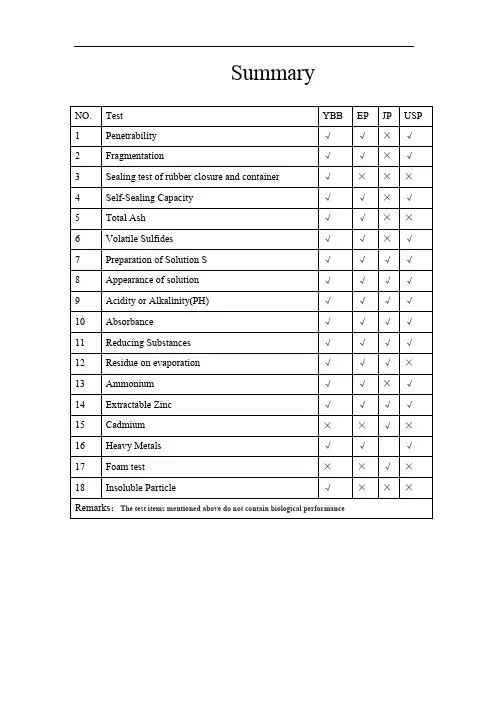
Summary1、Penetrability[YBB]Take 10 rubber closures, test according to the second method of YBB60072012, the average puncture force does not exceed 10N.[EP] Fill 10 suitable vials to the nominal volume with water R, fit the closures to be examined and secure with a cap. Using for each closure a new, lubricated long-bevel(1) (bevel angle 12 ± 2°) hypodermic needle with an external diameter of 0.8 mm, pierce the closures with the needle perpendicular to the surface. The force required for piercing, determined with an accuracy of ± 0.25 N (25 gf), is not greater than 10 N (1 kgf) for each closure.[JP]None[USP]Fill 10 suitable vials to the nominal volume with water, fit the closures to be examined, and secure with a cap. Using a new hypodermic needle as described above for each closure, pierce the closure with the needle perpendicular to the surface.Requirement—The force for piercing is no greater than 10 N (1 kgf) for each closure, determined with an accuracy of ± 0.25 N (25 gf).2、Fragmentation[YBB]Take 10 rubber closures, test according to the second method of YBB60082012, The total number of fragments does not exceed 5.[EP] For closures intended to be pierced by a hypodermic needle, carry out the following test. If the closures are to be used for aqueous preparations, place in12 clean vials a volume of water R corresponding to the nominal volume minus4 ml, close the vials with the closures to be examined, secure with a cap andallow to stand for 16 h. If the closures are to be used with dry preparations, close 12 clean vials with the closures to be examined. Using a lubricated long-bevel(1) (bevel angle 12 ±2°) hypodermic needle with an external diameter of 0.8 mm fitted to a clean syringe, inject into the vial 1 ml of water R and remove 1 ml of air ; carry out this operation 4 times for each closure, piercing each time at a different site. Use a new needle for each closure and check that the needle is not blunted during the test. Pass the liquid in the vials through a filter having approxi mately 0.5 μm pores. Count the fragments of rubber visible to the naked eye. The total number of fragments does not exceed5. This limit is based on the assumption that fragments with a diameter equal toor greater than 50 μm are visible to the naked eye; in cases of doubt or dispute, the fragments are examined with a microscope to verify their nature and size. [JP] None[USP] Closures for Liquid Preparations— Fill 12 clean vials with water to 4 mL less than the nominal capacity. Fit the closures to be examined, secure with acap, and allow to stand for 16 hours.Closures for Dry Preparations— Fit closures to be examined into 12 cleanvials, and secure each with a cap.Procedure— Using a hypodermic needle as described above fitted to a cleansyringe, inject into each vial 1 mL of water while removing 1 mL of air. Repeat this procedure 4 times for each closure, piercing each time at a different site.Use a new needle for each closure, checking that it is not blunted during the test.Filter the toatal volume of liquid in all the vials through a single filter with a nominal pore size no greater than 0.5 µm. Count the rubber fragments on the surface of the filter visible to the naked eye.Requirement— There are no more than 5 fragments visible. This limit is based on the assumption that fragments with a diameter >50 µm are visible to the naked eye. In case of doubt or dispute, the particles are examined microscopically to verify their nature and size.3、Sealing test of rubber closure and container[YBB] Take 10 rubber closures into the beaker, boil for 5 min , take out and dry 1h at 70℃ and ready to use. Fill 10 suitable vials to the nominal volume with water, fit the closures to be examined and secure with a cap. Heat in an autoclave so that a temperature of 121 ± 2 °C and maintain at this temperature for 30 min.Cool to room temperature and then place 24h, Immerse the vials upside down ina 10% solution of methylene blue R and reduce the external pressure by 25 kPafor 30 min. Restore atmospheric pressure and leave the vials immersed for 30 min. Rinse the outside of the vials. None of the vials contains any trace of colored solution.[EP]None[JP]None[USP] None4、Self-Sealing Capacity[YBB]Take the samples from sealing test of rubber closure and container, using for a hypodermic needle (YBB60082012 method 2), pierce each closure 3 times, change the hypodermic needle after it is used 10 times ,piercing each time at a different site.The vials upside down in a 10% solution of methylene blue R and reduce the external pressure by 25 kPa for 30 min. Restore atmospheric pressure and leave the vials immersed for 30 min. Rinse the outside of the vials. None of the vials contains any trace of colored solution.[EP]For closures intended to be used with multidose containers, carry out the following test. Fill 10 suitable vials to the nominal volume with water R, fit the closures to be examined and secure with a cap. Using for each closure a new hypodermic needle with an external diameter of 0.8 mm, pierce each closure 10 times, piercing each time at a different site. Immerse the vials upright in a 1 g/l solution of methylene blue R and reduce the external pressure by 27 kPa for 10 min. Restore atmospheric pressure and leave the vials immersed for 30 min.Rinse the outside of the vials. None of the vials contains any trace of coloured solution.[JP]None[USP]Procedure—Fill 10 suitable vials with water to the nominal volume. Fit the closures that are to be examined, and cap. Using a new hypodermic needle as described above for each closure, pierce each closure 10 times, piercing each time at a different site. Immerse the 10 vials in a solution of 0.1% (1 g per L) methylene blue, and reduce the external pressure by 27 kPa for 10 minutes.Restore to atmospheric pressure, and leave the vials immersed for 30 minutes.Rinse the outside of the vials.Requirement—None of the vials contain any trace of blue solution.5、Total Ash[YBB] Take the rubber closures, test according to YBB600212012, should be comply with the standard.[EP]The total ash (2.4.16) is within ± 10 per cent of the result obtained with the type sample.[JP]None[USP] None6、Volatile Sulfides[YBB]Take the rubber closures, according to the YBB60052012, should be comply with the standard.[EP] Place closures, cut if necessary, with a total surface area of 20 ± 2 cm2 in a 100 ml conical flask and add 50 ml of a 20 g/l solution of citric acid R. Place a piece of lead acetate paper R over the mouth of the flask and maintain the paper in position by placing over it an inverted weighing bottle. Heat in an autoclave at 121 ± 2℃ for 30 min. Any black stain on the paper is not more intense than that of a standard prepared at the same time in the same manner using 0.154 mg of sodium sulphide R and 50 ml of a 20 g/l solution of citric acid R.[JP]None[USP] Procedure— Place closures, cut if necessary, with a total surface area of 20 ± 2 cm2 in a 100-mL flask, and add 50 mL of a 20 g per L citric acid solution. In the same manner and at the same time, prepare a control solution in a separate 100-mL flask by dissolving 0.154 mg of sodium sulfide in 50 mL of a 20 g per L citric acid solution. Place a piece of lead acetate paper over the mouth of each flask, and hold the paper in position by placing over it an inverted weighing bottle. Heat the flasks in an autoclave at 121 ± 2℃for 30minutes.Requirement—Any black stain on the paper produced by Solution S is not more intense than that produced by the control solution.7、Preparation of Solution S[YBB] Put a number of uncut closures corresponding to a surface area of about 200 cm2 in a suitable glass container, cover with purified water( sample: water=1:2), boil for 5 min and rinse 5 times with the same volume of purified water. Place the washed closures in a conical flask, add the same volume of water and weigh.Cover the mouth of the flask with a borosilicate-glass beaker. Heat in an autoclave so that a temperature of 121 ± 2 °C is reached within 20 min to 30 min and maintain at this temperature for 30 min. Cool to room temperature.Make up to the original mass with purified water. Shake and immediately separate the solution from the rubber by decantation. Shake solution S before each test Blank. Prepare a blank in the same manner using 400 mL of water for purified water.[EP] Solution S.Introduce a number of uncut closures corresponding to a surface area of about 100 cm2in a suitable glass container, cover with water for injections R, boil for 5 min and rinse 5 times with cold water for injections R.Place the washed closures in a wide-necked flask (glass type I, 3.2.1), add 200 ml of water for injections R and weigh. Cover the mouth of the flask with a borosilicate-glass beaker. Heat in an autoclave so that a temperature of 121 ±2 °C is reached within 20 min to 30 min and maintain at this temperature for 30min. Cool to room temperature over about 30 min. Make up to the original mass with water for injections R. Shake and immediately separate the solution from the rubber by decantation. Shake solution S before each testBlank. Prepare a blank in the same manner using 200 ml of water for injections R.[JP] Wash the rubber closures with water, and dry at room temperature. Place them in a glass container, add water exactly 10 times the mass of the test material, close with a suitable stopper, heat at 121℃ for 1 hour in an autoclave, take out the glass container, allow to cool to room temperature,then take out immediately the rubber closures, and use the remaining solution as the testsolution. Prepare the blank solution with water in the same manner. Perform the following tests with the test solution and the blank solution[USP] Place whole, uncut closures corresponding to a surface area of 100 ± 10 cm2 intoa suitable glass container. Cover the closures with 200 mL of Purified Water orWater for Injection. If it is not possible to achieve the prescribed closure surface area (100 ± 10 cm2) using uncut closures, select the number of closures that will most closely approximate 100 cm2, and adjust the volume of water used to the equivalent of 2 mL per each 1 cm2 of actual closure surface area used. Boil for 5 minutes, and rinse five times with cold Purified Water or Water for InjectionPlace the washed closures into a Type I glass wide-necked flask (see Containers—Glass 660 ), add the same quantity of Purified Water or Water for Injection initially added to the closures, and weigh. Cover the mouth of the flask with a Type I glass beaker. Heat in an autoclave so that a temperature of 121 ± 2℃ is reached within 20 to 30 minutes, and maintain this temperature for30 minutes. Cool to room temperature over a period of about 30 minutes. AddPurified Water or Water for Injection to bring it up to the original mass. Shake, and immediately decant and collect the solution. [NOTE—This solution must be shaken before being used in each of the tests]Prepare a blank solution similarly, using 200 mL of Purified Water or Water for Injection omitting the closures8、Appearance of solution[YBB]According to the part 2 of Chinese pharmacopoeia, 2010 edition of appendixⅨB and appendix IX A, standard solution is not more opalescent than reference suspension II. Standard solution is not more intensely coloured than No.5 reference solution[EP] Solution S is not more opalescent than reference suspension II for type I closures and is not more opalescent than reference suspension III for type II closures(2.2.1). Solution S is not more intensely coloured than reference solution GY5(2.2.2, Method II).[JP] Place 5 mL of the test solution in a glass-stoppered test tube of about 15 mm in inner diameter and about 200 mm in length, and shake vigorously for 3 minutes.The foam arisen disappears almost completely within 3 minutes.[USP] Determination of Turbidity (Opalescence)Procedure A: Visual Comparison— Use identical test tubes made of colorless, transparent, neutral glass with a flat base and an internal diameter of 15 to 25 mm. Fill one tube to a depth of 40 mm with Solution S, one tube to the same depth with water, and four others to the same depth with Reference Suspensions A, B, C,and D. Compare the solutions in diffuse daylight 5 minutes after preparation of the Reference Suspensions, viewing vertically against a black background. The light conditions shall be such that Reference Suspension A can be readily distinguished from water and that Reference Suspension B can be readily distinguished fromReference Suspension A.REQUIREMENT—Solution S is not more opalescent than Reference Suspension B for Type I closures, and not more opalescent than Reference Suspension C for Type II closures. Solution S is considered clear if its clarity is the same as that of water when examined as described above, or if its opalescence is not more pronounced than that of Reference Suspension A (refer to Table 3).Procedure B: Instrumental Comparison—Measure the turbidity of theReference Suspensions in a suitable calibrated turbidimeter (see Spectrophotometry and Light Scattering 851 ). The blank should be run and the results corrected for the blank. Reference Suspensions A, B, C, and D represent 3, 6, 18 and 30 Nephelometric Turbidity Units (NTU), respectively. Measure the turbidity of Solution S using the calibrated turbidimeter. REQUIREMENT—The turbidity of Solution S is not greater than that for Reference Suspension B (6 NTU FTU) for Type I closures, and is not greater than that forReference Suspension C (18 NTU FTU) for Type II closures (refer to Table 3).Determination of ColorColor Standard— Prepare a solution by diluting 3.0 mL of Matching Fluid O (see Color and Achromicity 631 ) with 97.0 mL of diluted hydrochloric acid. Procedure—Use identical tubes made of colorless, transparent, neutral glass with a flat base and an internal diameter of 15 to 25 mm. Fill one tube to a depth of 40 mm with Solution S, and the second with Color Standard. Compare the liquids in diffuse daylight, viewing vertically against a white background. Requirement—Solution S is not more intensely colored than the Color Standard.9、Acidity or Alkalinity(PH)[YBB]Take each of 20 ml blank solution and solution S, respectively with KCl solution1 ml, According to the part2 of Chinese pharmacopoeia, 2010 edition ofappendixⅥH, the difference between the two may not be over 1.0.[EP] To 20ml of solution S add 0.1ml of bromothymol blue solution R1. Not more than 0.3ml of 0.01 M sodium hydroxide or 0.8 ml of 0.01 M hydrochloric acid is required to obtain either a blue or a yellow colour, respectively.[JP] To 20 mL each of the test solution and the blank solution add 1.0 mL each of potassium chloride solution, prepared by dissolving 1.0 g of potassium chloride in water to make 1000 mL. The difference of pH between the two solutions is not more than 1.0[USP] Bromothymol Blue Solution—Dissolve 50 mg of bromothymol blue in a mixture of 4 mL of 0.02 M sodium hydroxide and 20 mL of alcohol. Dilute with water to 100 mL.Procedure— To 20 ml of Solution S add 0.1 ml of Bromothymol Blue Solution.If the solution is yellow, titrate with 0.01 N sodium hydroxide until a blue endpoint is reached. If the solution is blue, titrate with 0.01 N hydrochloric acid until a yellow endpoint is reached. If the solution is green, it is neutral and no titration is required.Blank Correction—Test 20 mL of Blank similarly. Correct the results obtained for Solution S by subtracting or adding the volume of titrant required for the Blank, as appropriate. (Reference Titrimetry 541 .)Requirement— Not more than 0.3 ml of 0.01 N sodium hydroxide produces a blue color, or not more than 0.8 ml of 0.01 N hydrochloric acid produces a yellow color, or no titration is required.10、Absorbance[YBB] Filter solution S on a membrane filter having approximately 0.45 μm pores.Measure the absorbance of the filtrate at wavelengths from 220 nm to 360 nm using the blank as compensation liquid. At these wavelengths, the absorbance does not exceed 0.1(according to the part 2 of Chinese pharmacopoeia, 2010 edition of appendixⅣA).[EP] Carry out the test within 5 h of preparation of solution S. Filter solution S on a membrane filter having approximately 0.45 μm pores rejecting the first few milliliters of filtrate. Measure the absorbance (2.2.25) of the filtrate at wavelengths from 220 nm to 360 nm using the blank (see solution S) as compensation liquid. At these wavelengths, the absorbance does not exceed 0.2 for type I closures or 4.0 for type II closures. If necessary, dilute the filtrate before measurement of the absorbance and correct the result for the dilution. [JP] Read the absorbance of the test solution between 220 nm and 350 nm against the blank solution as directed under Ultraviolet-visible Spectrophotometry <2.54>: it is not more than 0.20.[USP] Procedure — [NOTE—Perform this test within 5 hours of preparing Solution S.] Filter Solution S through a 0.45-µm pore size filter, discarding the first few mL of filtrate. Measure the absorbance of the filtrate at wavelengths between 220 and 360 nm in a 1-cm cell using the blank in a matched cell in the reference beam. If dilution of the filtrate is required before measurement of the absorbance, correct the test results for the dilution.Requirement—The absorbances at these wavelengths do not exceed 0.2 for Type I closures or 4.0 for Type II closures.11、Reducing Substances[YBB] To 20.0 mL of solution S add 1 mL of dilute sulfuric acid R and 20.0 mL of0.002 M potassium permanganate. Boil for 3 min. Cool. Add 0.1 g of potassiumiodide R and titrate immediately with 0.01 M sodium thiosulfate until the colorturned light brown , using 5 drops of starch solution R as indicator. Carry out atitration using 20.0 mL of the blank. The difference between the titrationvolumes is not greater than7.0mL.[EP] Carry out the test within 4 h of preparation of solution S. To 20.0 ml of solution S add 1 ml of dilute sulphuric acid R and 20.0 ml of 0.002 M potassium permanganate. Boil for 3min. Cool. Add 1 g of potassium iodide R and titrate immediately with 0.01 M sodium thiosulphate, using 0.25 ml of starch solution R as indicator. Carry out a titration using 20.0 ml of the blank. The difference between the titration volumes is not greater than 3.0 ml for type I closures and7.0 ml for type II closures.[JP] Measure 100 mL of the test solution in a glass-stoppered,Erlenmyer flask, add10.0 mL of 0.002 mol/L potassium permanganate VS and 5 mL of dilutesulfuric acid, and boil for 3 minutes. After cooling, add 0.10 g of potassium iodide,stopper, mix by shaking, then allow to stand for 10 minutes,and titrate<2.50> with 0.01 mol/L sodium thiosulfate VS(indicator: 5 drops of starch TS).Perform the blank test in the same manner, using 100 mL of the blank solution.The difference in mL of 0.002 mol/L potassium permanganate VS required between the tests is not more than 2.0 mL.[USP] Procedure— [NOTE—Perform this test within 4 hours of preparing Solution S.] To 20.0 mL of Solution S add 1 mL of diluted sulfuric acid and 20.0 mL of0.002 M potassium permanganate. Boil for 3 minutes. Cool, add 1 g ofpotassium iodide, and titrate immediately with 0.01 M sodium thiosulfate, using0.25 mL of starch solution TS as the indicator. Perform a titration using 20.0mL of blank and note the difference in volume of 0.01 M sodium thiosulfaterequired.Requirement—The difference between the titration volumes is not greater than 3.0 mL for Type I closures and not greater than 7.0 mL for Type II closures.12、Residue on evaporation[YBB]Evaporate 100 mL of solution S and blank solution to dryness on a water-bath and dry at 100 °C to 105 °C. The residue weighs not more than 4.0 mg. [EP]Evaporate 50.0 ml of solution S to dryness on a water-bath and dry at 100 °C to 105 °C. The residue weighs not more than 2.0 mg for type I rubber and notmore than 4.0 mg for type II rubber.[JP]Measure 100 mL of the test solution, evaporate on a water bath to dryness, and dry the residue at 1059 C for 1 hour.The mass of the residue is not morethan 2.0 mg.[USP]None13、Ammonium[YBB] Precision measuring 10 ml of solution S, adding alkaline potassium iodide solution 2 ml, place 15 minutes, should not be color; if it colored , compare with reference solution (with 2.0 ml ammonium chloride solution (take ammoniumchloride 31.5 mg, add right amount chlorine free water and dissolve diluted to1000 ml), 8 ml blank reference solution, 2ml alkaline potassium mercuric iodide solution for mixing), should not be more intensely colored (0.0002%)[EP] maximum 2 ppm.Dilute 5 ml of solution S to 14 ml with water R. The solution complies with limit test A.[JP]None[USP] Alkaline Potassium Tetraiodomercurate Solution— Prepare a 100 mL solution containing 11 g of potassium iodide and 15 g of mercuric iodide in water.Immediately before use, mix 1 volume of this solution with an equal volume ofa 250 g per L solution of sodium hydroxide.Test Solution— Dilute 5 mL of Solution S to 14 mL with water. Make alkaline if necessary by adding 1 N sodium hydroxide, and dilute with water to 15 mL.Add 0.3 mL of Alkaline Potassium Tetraiodomercurate Solution, and close the container.Ammonium Standard Solution— Prepare a solution of ammonium chloride in water (1 ppm NH4). Mix 10 mL of the 1 ppm ammonium chloride solution with5 mL water and 0.3 mL of Alkaline Potassium Tetraiodomercurate Solution.Close the container.Requirement—After 5 minutes, any yellow color in the Test Solution is no darker than the Ammonium Standard Solution (no more than 2 ppm of NH4 in Solution S).14、Extractable Zinc[YBB] Filter solution S on a membrane filter having approximately 0.45μm pores, Precision measuring filtrate 10 ml, add 1 ml 2 mol/L of hydrochloric acid and 3 drops of potassium ferrocyanide test solution(weight 4.2 g potassium ferrocyanide trihydrate, dissolve and diluted with water to 100 ml, shake evenly, this product should be new prepared) for mixing, should not be color; if it colored, compare with reference solution( with 3 ml standard zinc solution (weight 44.0g Zinc sulfate seven hydrated compounds, with new boiled and cooled purified water dissolved and diluted to 1000 ml, this product should be new prepared), shall not be deeper(0.0002%),7ml blank reference solution, 1ml 2mol/L hydrochloric acid and 3 drops of potassium ferrocyanide solution for mixing), should not be more intensely colored.(0.0003%)[EP] maximumof 5 μg of extractable Zn per millilitre of solution S.Atomic absorption spectrophotometry (2.2.23, Method I). Test solution. Dilute10.0 ml of solution S to 100 ml with 0.1 M hydrochloric acid.Reference solutions. Prepare the reference solutions using zinc standard solution(10 ppm Zn) R diluted with 0.1 M hydrochloric acid.Source: zinc hollow-cathode lamp.Wavelength: 213.9 nm.Flame: air-acetylene.[JP]To 10.0 mL of the test solution add diluted dilute nitric acid (1 in 3) to make 20 mL, and use this solution as the sample solution. Further, to 1.0 mL of Standard Zinc Solutionfor atomic absorption spectrophotometry add diluted nitricacid (1 in 3) to make exactly 20 mL, and use this solution asthe standard solution. Perform the tests according to the Atomic Absorption Spectrophotometry <2.23>,using these solutions, under the following conditions.The absorbanceof the sample solution is not more than that of the standardsolution.Gas: Combustible gasóAcetylene.Supporting gasóAir.Lamp: Zinc hollow-cathode lamp.Wavelength: 213.9 nm.Standard Zinc Solution for atomic absorption spectrophotometry: Measure exactly 10 mL of the Standard Zinc Stock Solution, and add water to make exactly 1000 mL. Prepare before use. One mL of this solution contains 0.01 mg of zinc(Zn).[USP] Test Solution—Prepare a Test Solution by diluting 10.0 mL of Solution S to 100 mL with 0.1N hydrochloric acid. Prepare a test blank similarly, using the Blank forSolution S.Zinc Standard Solution— Prepare a solution (10 ppm Zn) by dissolving zinc sulfate in 0.1 N hydrochloric acid.Reference Solutions—Prepare not fewer than 3 Reference Solutions by diluting the Zinc Standard Solution with 0.1 N hydrochloric acid. The concentrations of zinc in these Reference Solutions are to span the expected limit of the Test Solution.Procedure—Use a suitable atomic absorption spectrophotometer (see Spectrophotometry and Light Scattering 851 ) equipped with a zinc hollow-cathode lamp and an air–acetylene flame. An alternative procedure such as an appropriately validated inductively coupled plasma analysis (ICP) may be used.Test each of the Reference Solutions at the zinc emission line of 213.9 nm at least 3 times. Record the steady readings. Rinse the apparatus with the test blank solution each time, to ensure that the reading returns to initial blank value.Prepare a calibration curve from the mean of the readings obtained for each Reference Solution. Record the absorbance of the Test Solution. Determine the ppm zinc concentration of the Test Solution using the calibration curve.Requirement— Solution S contains not more than 5 ppm of extractable zinc.15、Cadmium[YBB]None[EP]None[JP]Wash the rubber closures with water, dry at room temperature, cut into minute pieces, mix well, place 2.0 g of them in a crucible of platinum or quartz, moisten them with 2 mL of sulfuric acid, heat gradually to dryness, and ignite between 4509 Cand5009 C until the residue is incinerated. When in cineration was insufficient, moisten the residue with 1 mL of sulfuric acid, heat to dryness, and ignite again. Repeat the above-mentioned procedure if necessary. Cool the crucible,moisten the residue with water, add 2 to 4 mL of hydrochloric acid, heat on a water bath to dryness, add 1 to 5 mL of hydrochloric acid, and dissolve by heating. Then add 0.5 to 1 mL of a mixture of a solution of citric acid monohydrate (1 in 2) and hydrochloric acid (1:1) and 0.5 to 1 mL of a warmed solution of ammonium acetate (2 in 5). When any insoluble residue remains, filter through a glass filter. To the solution thus obtained add 10 mL ofa solution of diammonium hydrogen citrate (1 in 4), 2 drops of bromothymolblue TS and ammonium TS until the color of the solution changes from yellow to green. Then add 10 mL of ammonium sulfate solution (2 in 5) and water to make 100 mL. Next, add 20 mL of a solution of sodium N,N-diethyldithiocarbamate trihydrate (1 in 20), mix, allow to stand for a few minutes,add 20.0 mL of 4-methyl-2-pentanone, and mix by vigorous shaking.Allow to stand to separate the 4-methyl-2-pentanone layer from the solution, filter if necessary, and use as the sample solution. On the other hand, to 10.0 mL of Standard Cadmium Solution add 10 mL of a solution of diammonium hydrogen citrate (1 in 4) and 2 drops of bromothymol blue TS, proceed in the same manner as for the sample solution, and use this solution as the standard solution.Perform the tests according to the Atomic Absorption Spectrophotometry <2.23> under the following conditions, using the sample solution and the standard solution. The absorbance of the sample solution is notmore than that of thestandard solution.Gas: Combustible gas—Acetylene or hydrogen.Supporting gas—Air.Lamp: Cadmium hollow-cathode lamp.Wavelength: 228.8 nm.[USP] None。
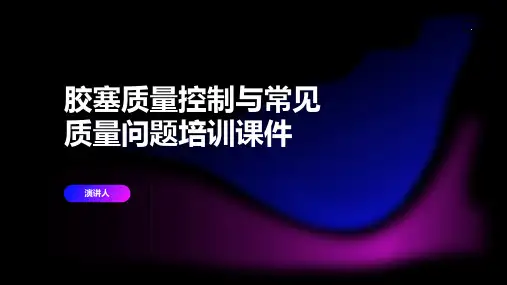
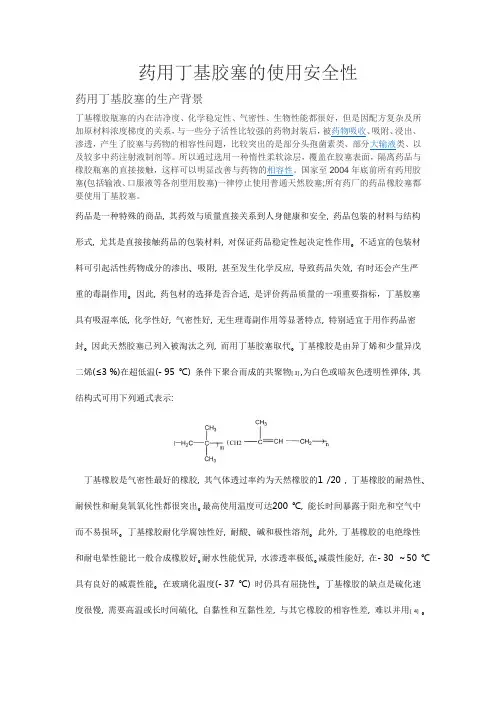
药用丁基胶塞的使用安全性药用丁基胶塞的生产背景丁基橡胶瓶塞的内在洁净度、化学稳定性、气密性、生物性能都很好,但是因配方复杂及所加原材料浓度梯度的关系,与一些分子活性比较强的药物封装后,被药物吸收、吸附、浸出、渗透,产生了胶塞与药物的相容性问题,比较突出的是部分头孢菌素类、部分大输液类、以及较多中药注射液制剂等。
所以通过选用一种惰性柔软涂层,覆盖在胶塞表面,隔离药品与橡胶瓶塞的直接接触,这样可以明显改善与药物的相容性。
国家至2004年底前所有药用胶塞(包括输液、口服液等各剂型用胶塞)一律停止使用普通天然胶塞;所有药厂的药品橡胶塞都要使用丁基胶塞。
药品是一种特殊的商品, 其药效与质量直接关系到人身健康和安全, 药品包装的材料与结构形式, 尤其是直接接触药品的包装材料, 对保证药品稳定性起决定性作用。
不适宜的包装材料可引起活性药物成分的渗出、吸附, 甚至发生化学反应, 导致药品失效, 有时还会产生严重的毒副作用。
因此, 药包材的选择是否合适, 是评价药品质量的一项重要指标,丁基胶塞具有吸湿率低, 化学性好, 气密性好, 无生理毒副作用等显著特点, 特别适宜于用作药品密封。
因此天然胶塞已列入被淘汰之列, 而用丁基胶塞取代。
丁基橡胶是由异丁烯和少量异戊二烯(≤3 %)在超低温(- 95 ℃) 条件下聚合而成的共聚物[ 3] ,为白色或暗灰色透明性弹体,其结构式可用下列通式表示:丁基橡胶是气密性最好的橡胶, 其气体透过率约为天然橡胶的1 /20 , 丁基橡胶的耐热性、耐候性和耐臭氧氧化性都很突出。
最高使用温度可达200 ℃, 能长时间暴露于阳光和空气中而不易损坏。
丁基橡胶耐化学腐蚀性好, 耐酸、碱和极性溶剂。
此外, 丁基橡胶的电绝缘性和耐电晕性能比一般合成橡胶好。
耐水性能优异, 水渗透率极低。
减震性能好, 在- 30 ~50 ℃具有良好的减震性能。
在玻璃化温度(- 37 ℃) 时仍具有屈挠性。
丁基橡胶的缺点是硫化速度很慢, 需要高温或长时间硫化, 自黏性和互黏性差, 与其它橡胶的相容性差, 难以并用[ 4] 。
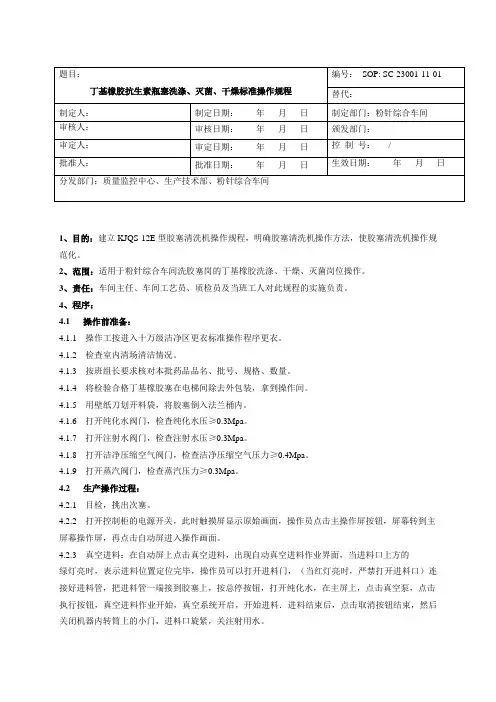
1、目的:建立KJQS-12E型胶塞清洗机操作规程,明确胶塞清洗机操作方法,使胶塞清洗机操作规范化。
2、范围:适用于粉针综合车间洗胶塞岗的丁基橡胶洗涤、干燥、灭菌岗位操作。
3、责任:车间主任、车间工艺员、质检员及当班工人对此规程的实施负责。
4、程序:4.1 操作前准备:4.1.1 操作工按进入十万级洁净区更衣标准操作程序更衣。
4.1.2 检查室内清场清洁情况。
4.1.3 按班组长要求核对本批药品品名、批号、规格、数量。
4.1.4 将检验合格丁基橡胶塞在电梯间除去外包装,拿到操作间。
4.1.5 用壁纸刀划开料袋,将胶塞倒入法兰桶内。
4.1.6 打开纯化水阀门,检查纯化水压≥0.3Mpa。
4.1.7 打开注射水阀门,检查注射水压≥0.3Mpa。
4.1.8 打开洁净压缩空气阀门,检查洁净压缩空气压力≥0.4Mpa。
4.1.9 打开蒸汽阀门,检查蒸汽压力≥0.3Mpa。
4.2 生产操作过程:4.2.1 目检,挑出次塞。
4.2.2 打开控制柜的电源开关,此时触摸屏显示原始画面,操作员点击主操作屏按钮,屏幕转到主屏幕操作屏,再点击自动屏进入操作画面。
4.2.3 真空进料:在自动屏上点击真空进料,出现自动真空进料作业界面,当进料口上方的绿灯亮时,表示进料位置定位完毕,操作员可以打开进料门,(当红灯亮时,严禁打开进料口)连接好进料管,把进料管一端接到胶塞上,按总停按钮,打开纯化水,在主屏上,点击真空泵,点击执行按钮,真空进料作业开始,真空系统开启,开始进料.进料结束后,点击取消按钮结束,然后关闭机器内转筒上的小门,进料口旋紧,关注射用水。
4.2.4 在主操作屏,点击设定屏,在设定屏设定以下参数:冲洗时间:15—18min 清洗转速:2蒸汽灭菌温度:12l℃灭菌时间:35min 灭菌后真空时间:17min 烘干温度:105℃干燥时间:17min真空干燥时间:7min 真空干燥循环:2 冷却温度:90—99℃出料转速:4-8 启/停时间:1-44.2.5 冲洗:点击8。
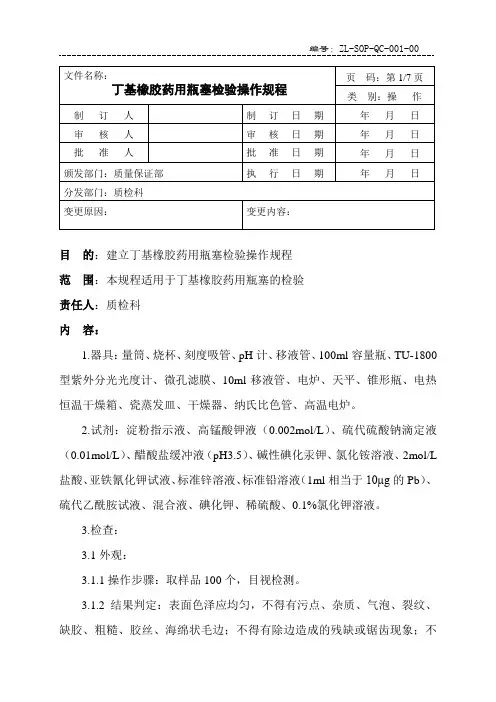
编号:ZL-SOP-QC-001-00目的:建立丁基橡胶药用瓶塞检验操作规程范围:本规程适用于丁基橡胶药用瓶塞的检验责任人:质检科内容:1.器具:量筒、烧杯、刻度吸管、pH计、移液管、100ml容量瓶、TU-1800型紫外分光光度计、微孔滤膜、10ml移液管、电炉、天平、锥形瓶、电热恒温干燥箱、瓷蒸发皿、干燥器、纳氏比色管、高温电炉。
2.试剂:淀粉指示液、高锰酸钾液(0.002mol/L)、硫代硫酸钠滴定液(0.01mol/L)、醋酸盐缓冲液(pH3.5)、碱性碘化汞钾、氯化铵溶液、2mol/L 盐酸、亚铁氰化钾试液、标准锌溶液、标准铅溶液(1ml相当于10μg的Pb)、硫代乙酰胺试液、混合液、碘化钾、稀硫酸、0.1%氯化钾溶液。
3.检查:3.1外观:3.1.1操作步骤:取样品100个,目视检测。
3.1.2结果判定:表面色泽应均匀,不得有污点、杂质、气泡、裂纹、缺胶、粗糙、胶丝、海绵状毛边;不得有除边造成的残缺或锯齿现象;不得有模具造成的明显痕迹,判为合格。
3.2灰分:3.2.1操作步骤:3.2.1.1分别称取样品1.0g两份,放入已炽灼至恒重的两个坩埚中,精密称定;3.2.1.2放入高温电炉中,缓缓炽灼至完全炭化;3.2.1.3再放入800℃炽灼至完全灰化,移置干燥器内;3.2.1.4放冷至室温,精密称定后,再在800℃炽灼至恒重。
4.2.2结果判定:遗留残渣不得过45%,判为合格。
3.3澄清度与颜色:3.3.1操作步骤:取供试液10.0ml置纳氏比色管中。
4.3.2结果判定:溶液应澄清无色。
如显浑浊,与2号浊度标准液比较,不得更浓;如显色,与黄绿色5号标准比色液比较,不得更浓,判为合格。
3.3.3注:试验液S1和空白液S0的制备按《丁基橡胶药用瓶塞质量标准》进行。
3.4酸碱度3.4.1操作步骤3.4.1.1用量筒分别量取试验液S1和空白液S0各20ml,置两个小烧杯中。
3.4.1.2向两个小烧杯中各加入氯化钾溶液(1→1000)1.0ml。
![药用丁基胶塞质量标准[指南]](https://uimg.taocdn.com/b89569fa77232f60dccca1ad.webp)
药用丁基胶塞质量标准[指南]药用丁基胶塞质量标准药用氯化丁基橡胶塞标准(试行) YBB 00042002本标准适用于直接与注射剂接触的氯化丁基橡胶塞。
【外观】取本品数个,目视检测,表面色泽应均匀,不得有污点、杂质、气泡、裂纹、缺胶、粗糙、胶丝、胶屑、海绵状、毛边;不得有除边造成的残缺或锯齿现象;不得有模具造成的明显痕迹。
【鉴别】(1)称取本品5,20g,置于干燥的试管中,将长约4毫米的钠片一片置于固定并倾斜的试管中,使其恰好位于试样之上,用火焰的尖端加热试管,将钠融化在试样上,继续加热2分钟,使呈深红色,冷却后加入乙醇,将过剩的钠醇化,加水约10ml溶解,过滤,滤液备用。
A:取滤液1.5ml置于试管中,加硝酸酸化,煮沸1,2分钟,加入硝酸银1滴,应产生白色沉淀。
B:取滤液0.2ml,置于微量试管中,加氯仿1滴,加稀硫酸1滴,加薪配置的氨水1滴(或3,H2O2溶液2,3滴),经振荡混匀后,静止5分钟,氯仿层应不显色。
(2)红外光谱取本品约3g切成3mm×3mm小块置索氏抽提器中用丙酮或适宜的溶剂回流浸提8小时,取残渣80?烘干,取0.1,0.2g置于裂解管的底部,然后用试管夹水平的将裂解管移到酒精灯上加热,当出现裂解产物冷凝在裂解管冷端时,再继续加热至裂解基本完全但没碳化为止,取少许裂解物滴在溴化钾片上,在80?烘干,照分光光度法(《中华人民共和国药典》2000年版二部?C)测定,应与对照图谱基本一致。
【穿刺落屑】输液瓶用胶塞:取10只被测胶塞和10只已知穿落屑数的胶塞分别装在与其相配的输液瓶上,每只瓶中注入半瓶水。
加上铝盖,用手动封盖机封口,打开铝盖穿刺部位。
按先被测胶塞再已知穿刺落屑数胶塞的顺序交替穿刺胶塞。
穿刺时,胶塞保持直立,握持金属穿刺器(见图1)垂直向胶塞标记区域内穿刺,晃动数秒后拨出穿刺器。
每次穿刺前用丙酮或甲基—异丁基酮擦拭穿刺器。
穿刺器不得有损坏,并保持锋利(如穿器损坏,须换用新的)。
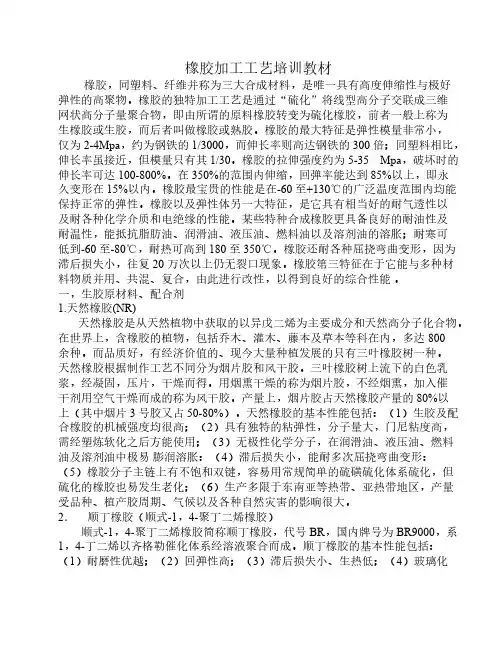
橡胶加工工艺培训教材橡胶,同塑料、纤维并称为三大合成材料,是唯一具有高度伸缩性与极好弹性的高聚物。
橡胶的独特加工工艺是通过“硫化”将线型高分子交联成三维网状高分子量聚合物,即由所谓的原料橡胶转变为硫化橡胶,前者一般上称为生橡胶或生胶,而后者叫做橡胶或熟胶。
橡胶的最大特征是弹性模量非常小,仅为2-4Mpa,约为钢铁的1/3000,而伸长率则高达钢铁的300倍;同塑料相比,伸长率虽接近,但模量只有其1/30。
橡胶的拉伸强度约为5-35 Mpa,破坏时的伸长率可达100-800%。
在350%的范围内伸缩,回弹率能达到85%以上,即永久变形在15%以内。
橡胶最宝贵的性能是在-60至+130℃的广泛温度范围内均能保持正常的弹性。
橡胶以及弹性体另一大特征,是它具有相当好的耐气透性以及耐各种化学介质和电绝缘的性能。
某些特种合成橡胶更具备良好的耐油性及耐温性,能抵抗脂肪油、润滑油、液压油、燃料油以及溶剂油的溶胀;耐寒可低到-60至-80℃,耐热可高到180至350℃。
橡胶还耐各种屈挠弯曲变形,因为滞后损失小,往复20万次以上仍无裂口现象。
橡胶第三特征在于它能与多种材料物质并用、共混、复合,由此进行改性,以得到良好的综合性能。
一,生胶原材料、配合剂1.天然橡胶(NR)天然橡胶是从天然植物中获取的以异戊二烯为主要成分和天然高分子化合物。
在世界上,含橡胶的植物,包括乔木、灌木、藤本及草本等科在内,多达800余种。
而品质好,有经济价值的、现今大量种植发展的只有三叶橡胶树一种。
天然橡胶根据制作工艺不同分为烟片胶和风干胶。
三叶橡胶树上流下的白色乳浆,经凝固,压片,干燥而得。
用烟熏干燥的称为烟片胶,不经烟熏,加入催干剂用空气干燥而成的称为风干胶。
产量上,烟片胶占天然橡胶产量的80%以上(其中烟片3号胶又占50-80%)。
天然橡胶的基本性能包括:(1)生胶及配合橡胶的机械强度均很高;(2)具有独特的粘弹性,分子量大,门尼粘度高,需经塑炼软化之后方能使用;(3)无极性化学分子,在润滑油、液压油、燃料油及溶剂油中极易膨润溶胀:(4)滞后损失小,能耐多次屈挠弯曲变形:(5)橡胶分子主链上有不饱和双键,容易用常规简单的硫磺硫化体系硫化,但硫化的橡胶也易发生老化;(6)生产多限于东南亚等热带、亚热带地区,产量受品种、植产胶周期、气候以及各种自然灾害的影响很大。

一、正确的穿刺部位及穿刺方法(请参照下图)
1.要在橡胶塞上指示的穿刺穿刺部位进行穿刺。
2.IN为加药时进针部位:OUT为输液时进针部位(见图示)
3.穿刺方法要得当,应使针头垂直刺入橡胶塞的OUT或IN处。
医用橡胶塞要求很严格,其特性可分为:
1.化学特性:材质、溶出物、吸附、与药液的反应等。
2.物理特性:抗剥落性、穿刺性、密闭性、微粒子的发生等。
选定、设计符合所有要求的橡胶塞,在技术上是相当困难的。
通常,为提高橡胶塞自身的密闭性,将橡胶塞的形状设计成可承受容器口部边缘压缩力的结构,但用注射针(不锈钢针头)穿刺橡胶塞时,橡胶因内压力而挤入针头内部,进而很容易被针尖的横倾面切下形成碎屑(见图1)。
图1发生掉屑的主要原因
该部分橡胶被横倾部切下
使用不锈钢针头穿刺橡胶塞时,一般有以下几种可能(见图2)
①针尖横倾面朝上斜着穿刺②垂直穿刺③针尖横倾面朝下斜着穿刺
有试验文献报导,穿刺部位和穿刺方法的不同,导致掉屑发生的数量也不同。
为防止橡胶塞穿在穿刺进发生掉屑,我们建议:
一、要在橡胶塞穿刺部位进行穿刺
在穿刺部位以外插针时,由于厚度较厚,会使掉屑数量增多,而在穿刺部位插针,则厚度较薄,可大大减少碎屑发生率。
二、穿刺方法要得当
斜着穿刺时,碎屑发生的数量较多,这是由于针尖横倾面与橡胶塞呈锐角,橡胶较易被切下,而垂直穿刺效果最好,斜着刺入时如能将针尖横倾面朝下,则碎屑发生也会减少。
三、最好使用侧口树脂针
目前,市场上输液器品种较多,但大多为不锈钢针,在使用时较易发生碎屑。
有一
种侧开口树脂针头,可避免在穿刺时发生掉屑,效果很好。
橡胶塞产品,使我们的产品日臻完美。
原。
(2)热原的产生与微生物的存在密切相关,因此对微生物的有效控制是至关重要的。
(3)注射用水水质的污染包括外源性污染和内源性污染。
外源性污染包括进料水、排气口或由于系统存在泄漏而与外界污染接触所致;内源性污染是系统运行中产生的,可能是水处理设备单元贮存与分配系统的设计、选材、安装、运行、维护和使用不当产生利于微生物生存、繁殖的生物膜所致。
(4)注射用水系统的水质保证体系包括硬件、软件和人员。
即硬件方面的合理设计、精心安装、严密验证、达标运行、有效监控和及时维护,只有在具有一定素质的人员,严格按相关软件要求去认真操作和管理,才能制造出合格的注射用水。
参考文献1 国家药品监督管理局. 药品生产质量管理规范 (1998年修订)2 缪德骅主编. 药品生产质量管理规范实施指南 北京:化学工业出版社,2001年3 张亚丰主编. 国药企业GM P与GM P认证实务全书 .吉林摄影出版社,2002年4 钱应璞. 制药用水系统设计与实践 .北京:化学工业出版社,2001年收稿日期:2003-12-15丁基橡胶药用瓶塞生产车间设计武汉医药设计院(430077) 罗 诚湖北工学院(430068) 孙凤兰摘要 本文较详细地介绍了丁基橡胶药用瓶塞的生产工艺和设备以及生产车间的设计。
关键词 丁基胶塞 生产车间 设计1 概述医用瓶塞是瓶装药物(如抗生素、冻干粉针、大输液、口服液)的主要封口件和导出件,由于它和药物直接或间接接触,因此必须满足药物对其的要求,不得与药物通过吸附、吸收、渗透和浸提等方式交互作用,从而影响或污染药物。
从生物角度要求,瓶塞必须无致热、无毒性;从卫生角度着眼,瓶塞必须洁净无菌;从药品的贮存来讲,瓶塞必须有良好的化学稳定性、气密性、耐老化性和低析出性;从瓶塞与瓶的配合考虑,瓶塞要有良好的弹性及物理机械性能;从临床使用考虑,瓶塞必须保证适宜的针刺力和低的落屑;与此同时,瓶塞的结构还必须满足药品生产封装的要求。
1.目的规范丁基胶塞的检测程序2.适用范围丁基胶塞的检测3.职责3.1. 质量管理部:负责本规程的起草、修订、审核、培训、实施和监督。
3.2. 质量管理部QC人员:负责本规程的实施。
3.3. 总经理:负责本规程的批准。
4.定义无5.引用标准《药品生产质量管理规范》2010年版6.材料6.1.仪器设备无6.2.器材、用具无6.3.其他无7.流程图无8.内容8.1.外观:取待检品数个,观察针刺圈内或与内容物接触面有无污点为、杂质、针刺圈内或密封面有无气泡、裂纹。
8.2. 穿刺落屑:选择与胶塞配套的500ml(口径26mm或28mm )20个,瓶内加1/2公称容量水,取待检品10个,已知穿刺落屑数的胶塞10个,分别装到瓶上,盖上铝塑组合盖,用手动封口机封口,放入高压蒸汽消毒器中,在121℃±2℃下保持30分钟,取出冷却至室温,分两排放置,第一排为被测胶塞,第二排为已知胶塞。
用丙酮或其它适当的有机溶剂擦拭金属穿刺针,然后将其浸在蒸馏水中。
手持穿刺针,垂直穿刺第一排第一个被刺胶塞上的标记部位,剌入后,晃动玻璃瓶数秒后,拔出穿刺针。
按上述步骤穿刺第二排第一个已知穿刺落屑数胶塞。
以此类推,按先被胶塞再已知穿刺落屑数胶塞的顺序,交替垂直穿刺胶塞上的标记部位,直至所有胶塞被穿刺一次。
将第一排瓶中水全部通过一张滤纸过滤,确保瓶中不残留落屑,在人眼距离滤纸25厘米的位置,用肉眼观察滤纸上的落屑数(相当于50μm以上的颗粒),必要时可通过显微镜进一步证实落屑大小和数量。
对已知穿刺落屑数的胶塞同法计数。
结果显示:分别记录两排瓶子的可见落屑数(即每十针的落屑总数)。
若已知穿刺落屑胶塞的结果与先已知的结果具有一致性,则应判被测胶塞测得结果有效。
反之,则无效。
在穿刺过程中,若有两个以上(含两个)胶塞在穿刺过程中被推入瓶中,则判该项不合格,若10个被测胶塞中有一个被推入瓶中,则另取10个胶塞重新试验,不得有胶塞被推入瓶中。
【关键词】丁基胶塞;使用;质量;体会[摘要]目的探讨丁基胶塞使用中存在的问题及解决办法。
方法对三年来我院制剂室丁基胶塞的使用情况进行总结。
结果解决了国产输液用丁基胶塞在使用过程中遇到的常见问题。
结论通过技术处理,国产输液用丁基胶塞基本上能满足生产要求。
[关键词]丁基胶塞;使用;质量;体会 Experiences in butyl rubbers application [Abstract] Objective To study the problems and treatments in butyl rubbers application. Methods To summarize the application of butyl rubber in our preparation department in the last three years.Results Solved the problems during the application of homemade butyl rubbers for infusion container.Conclusion With some scientific treatments,homemade butyl rubbers for infusion container satisfied all requirements of production ultimately. [Key words]butyl rubber;application;quality;experience 传统的输液用橡胶瓶塞为天然橡胶塞。
天然橡胶塞是从天然橡胶中提取出来的,由于含有对人体有害的异性蛋白等成分,密封性能也不好,因此会影响药品的疗效,从2005年起,药用丁基橡胶瓶塞作为Ⅰ类药用包材开始有计划强制性地取代天然橡胶瓶塞[1~4]。
这一转变给大容量注射剂生产企业带来了一定的挑战,在产品质量控制方面出现了新的不可控因素。
药用丁基胶塞的处理工艺设计摘要】目的探索药用丁基胶塞处理过程中参数控制与水分的关系,从而确定最佳参数的处理工艺。
方法通过处理不同数量的药用丁基胶塞和改变处理的参数〔干燥时间,F0值(标准灭菌时间)〕,用干燥失重法检测经处理后的药用丁基橡胶塞水分残留量,统计分析各参数条件下的用丁基胶塞水分残留量。
结果当F0值为15,干燥时间为60分钟时,胶塞的处理数量越大处理后的水分残留值越大;当胶塞的处理数量一定,F0值为15,干燥时间越长水分残留值越小;当胶塞的处理数量一定,干燥时间在60分钟时,F0值越大水分残留值越大。
结论经综合分析选用F0值为15,干燥时间为60分钟的处理工艺既符合生产工艺要求又节约能源。
【关键词】药用丁基橡胶塞 F0值水分干燥【中图分类号】R9 【文献标识码】A 【文章编号】2095-1752(2013)30-0115-02Design of treatment process for the medicinalbutyl rubbet stoppersHuang Xiaoqin ,Zhang Lin, Yao Xiulan,(Chongqing Kerui pharmacy Co.,Ltd, Chongqing,China 400060)【Abstract】Objective:To explore the medicinal butyl rubbet stoppers processing parameter control and water relations, and thus determine the optimal parameters of the treatment process. Methods:The number of medicinal butyl rubbet stoppers to deal with different and changing parameters (drying time, F0 value), with dry weight loss was detected after treatment, the medicinal butyl rubber plug water residue Statistical analysis of the parameters under the conditions of water use butyl rubbet stoppers residues. Results:When the F0 value is 15, the drying time of 60 minutes,the stopper of the handle the greater number of residual values of the treated water in the larger; when a certain amount of processing rubber plug, F0 value is 15,The longer the drying time of water the smaller the residual value; when a certain amount of stopper processing, drying time of 60 minutes, F0 value is greater the larger the valueof water left. Conclusion: After a comprehensive analysis of selected F0 value of 15,the drying time of 60 minutes of treatment processes are consistent with the requests for production processes and moisture content.【Key words】 medicinal butyl rubbet stoppers F0 value water drying 胶塞清洗机的清洗工艺是指进料、冲洗、粗洗、精洗、硅化、冲洗、灭菌、干燥、再热干燥和自动出料等全过程的工艺。